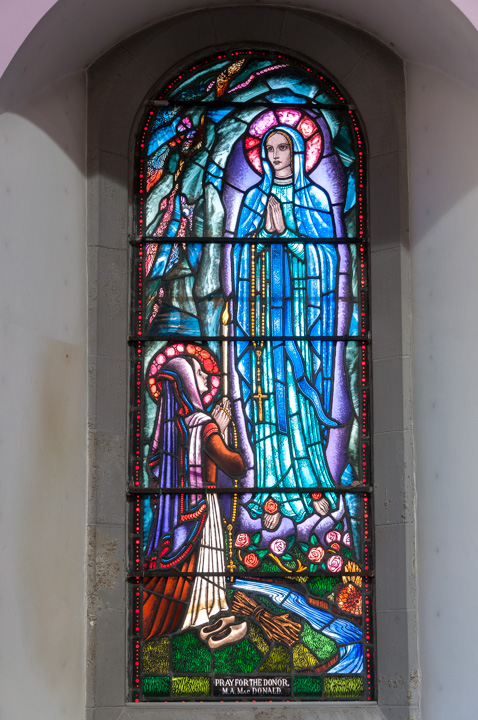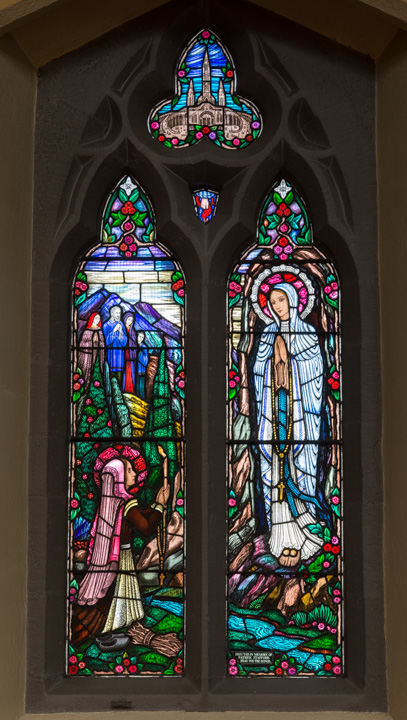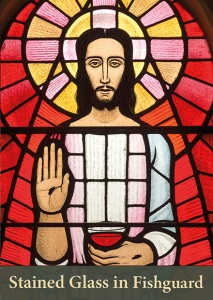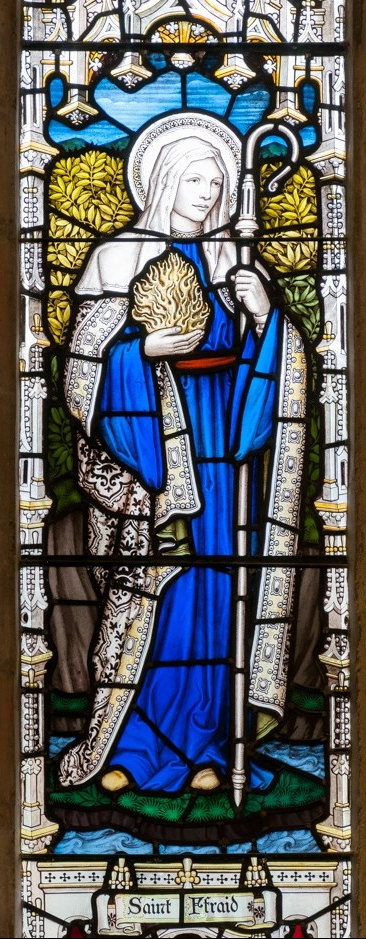Home » Posts tagged 'Ports Past and Present'
Tag Archives: Ports Past and Present
Stained Glass on Holy Island, Anglesey
The Ports, Past and Present project aimed to encourage tourists to explore the port towns connecting Wales and Ireland, rather than simply passing through on their way from one country to another.
I was first drawn to visit Holyhead many years ago to see the medieval church located on the site of a Roman fort, and I made subsequent visits to see stained glass at the town while gathering material for Stained Glass from Welsh Churches. As part of my contribution to the ports project I wrote and produced a guide to the stained glass from places of worship in Holyhead and at two other churches in the Benefice of Bro Cybi (Holy Island), Rhoscolyn and Trearddur Bay.
The importance of churches as a focus for faith tourism was highlighted in Wales by the Experiencing Sacred Wales project (2019–21), run by the National Churches Trust. As my advisory work for this project overlapped with my time working on Ports, Past and Present, it seemed appropriate to help local residents appreciate the stained glass in the town and encourage the idea that churches and their stained glass could offer a draw for visitors.
The booklet was launched on 1 July 2023 with a guided walking tour around all of the places in Holyhead where there was pictorial stained glass. Starting at the Maritime Museum, where two windows from the now demolished Church of St Seiriol are now preserved, we proceeded to the medieval church dedicated to St Cybi, the Catholic church and the Welsh Calvinistic Methodist Chapel, prior to a talk at Ucheldre Centre.
Apart from some coloured tracery lights in the nave of St Cybi’s, which probably date to the mid-nineteenth century, one of the windows from St Seiriol’s at the Maritime Museum appears to be the earliest pictorial stained glass in the town.
The window looked like it was the work of Heaton, Butler & Bayne, and this was confirmed by my discovery of a very similar window that I had tentatively attributed to them in Fowey. The window was listed and attributed to the firm by Michael Swift on his Cornish Stained Glass site, and securely dated to 1876.


The window at Holyhead was given in memory of Vice Admiral Charles Frederic Schomberg, who died in September 1874, and is therefore probably of a similar date. The two windows show Christ teaching from a boat and Christ calming the storm, both appropriate to churches found by the sea. The two windows make an interesting comparison with each other, showing how the designs of the two scenes were adapted for windows of different heights. The Fowey window has a brighter colouring suggestive of their earlier work, with strong blues for the skies at the tops of the windows, and greater use of yellow ochres and bright reds, while the more subdued colouring of the Holyhead window is more like their stained glass later in the 1870s and 80s.
The booklet includes stained glass by many others including C.E. Kempe, Morris & Co., James Powell & Sons, J. Wippell & Co., Christopher Charles Powell, Edward Payne and concludes with the impressive set of recent windows by Alan Davis at the Catholic church. These rank among the best sets of new windows for a church anywhere in Wales, with imaginative designs interpreting biblical themes rendered in a modern painterly style. The windows were a fortunate discovery that I made just in time to include in Stained Glass from Welsh Churches, necessitating a long last-minute day trip to photograph them for the book. The new little book on the glass of Holy Island provided a welcome opportunity to illustrate a different window with another detail on the back cover.

The front cover has a detail of the window given in memory of William Owen Stanley at St Cybi’s, made by Morris & Co. in 1897, and the subject of earlier comment on this blog nearly nine years ago.
I have written more on the patronage of the Stanleys in Holyhead for the Ports, Past and Present website.
Stained Glass in Fishguard
As part of my work on the Ports, Past and Present project, I produced a book on the stained glass in Fishguard, which was launched in March 2023. The book includes stained glass from two churches in the town as well as a window by Amber Hiscott in the library, and windows commissioned for the churches in Goodwick, closer to the ferry port, and Manorowen.
All of the stained glass windows were made in the twentieth century, with the earliest windows at Manorowen and Fishguard being made around 1920 by James Powell & Sons, Robert Newbery and Burlison & Grylls. The first windows at the Catholic church and St Peter’s in Goodwick also date from the 1920s, the buildings only dating from the early twentieth century. The low church tradition that had remained dominant under Revd William Rowlands at St Mary’s in Fishguard ensured that stained glass was not added until after his time. Neither candlesticks nor a cross were found on the altar when his successor arrived in 1894, and the first stained glass windows replaced plain glazing that required replacement at the end of the First World War.
The Catholic church has the only known window on the mainland by Dom Theodore Baily, who was a member of the Benedictine community on Caldey Island in the 1920s, and several of his windows can be found there. After the community left for Prinknash in 1928, the Dublin studio of Harry Clarke was called on to make the next window commissioned for the church. The only windows in Wales that have been attributed to Harry Clarke himself were made for All Saints in Penarth in 1928 and 1930, although they were lost in 1941. The window of St Thérèse of Lisieux was made by his studio for Fishguard in about 1929, and another was commissioned from the firm for the church in 1944.
The second window by Clarke’s depicts the Virgin Mary appearing to Bernadette at Lourdes, and is very similar to another window of the same scene in the Church of the Assumption in Wexford. The version at Fishguard is a single light-window while the window in Wexford is arranged over two lights: Mary occupies the right-hand light and Bernadette, with figures in the background, is in the left-hand light. I had initially wondered whether the patron of the window in Fishguard (Mrs M.A. MacDonald of Goodwick) had seen the version in Wexford and then commissioned something similar for her own church, but although the Fishguard window appears in the firm’s order books in 1944, I was unable to find a record of the Wexford window being commissioned. The order books, available on the website of Trinity College Dublin, only seem to go as far as 1951, so the version in Wexford was presumably made in the 1950s after the Fishguard window.


A curious note about the second window made by Clarke’s for the church in Fishguard on the Taking Stock website suggests that it had not been installed. The website referred to correspondence from the studio manager of the firm – and probable designer of the window – William Dowling, to the effect that the window had yet to be delivered to the church in 1973. This correspondence, and the separate survival of a panel depicting the lower part of the same scene that became available for auction in 2015, seemed to imply that the window never reached its intended destination. Nonetheless, as the window can now be found in the church in Fishguard, the panel formerly in the collection of the late David Clarke (1920–2005, son of Harry Clarke, 1889–1931), shows that a second version of the scene was also made as a single-light window.
Copies of Stained Glass in Fishguard can be obtained at St Mary’s Church and local bookshops in Fishguard, or online at my Sulien Books website.
Ports, Past and Present
Over the last couple of years I’ve been working part-time on the Ports, Past and Present project, which was funded by the European Regional Development Fund through the Ireland Wales Co-operation Programme to work with the communities around the five ferry ports that connect Wales with Ireland.
The project has been exploring the heritage of these places to promote tourism and deepen a sense of shared identities connected by the Irish Sea. In the last year of the project I led a couple of guided walks to see the stained glass in the towns, and gave talks on stained glass and medieval stories of the saints who journeyed across the sea.
The stained glass sometimes embodies or visualises the links between the two countries, such as the image of St Ffraid, or Brigid, in the east window of the church at Trearddur Bay, near Holyhead, travelling across the sea to Wales on a turf of grass. In the medieval church in Holyhead, the east window by C.E. Kempe was given in memory of William Watson, the managing director of the City of Dublin Steam Packet Company, and two windows by the Dublin firm of Clarke’s were made for the Catholic church in Fishguard.
Some of these stories of the saints with associated imagery can be found in my book Welsh Saints from Welsh Churches, and I have written a series of short pieces for the Ports, Past and Present website, which are presented as an online tour, ‘Saints and Stained Glass across the Sea’.
In the closing months of the project I also produced small books on the stained glass in and around Holyhead and Fishguard.





